Tradeoff between User Quality-Of-Experience and Service Provider Profit in 5G Cloud Radio Access Network
Abstract
:1. Introduction
- An integrated priority metric is developed so that the priority of an incoming request to a suitable BBU can be identified.
- Computational resource allocation problem for incoming requests is formulated as multi-objective non-linear programming optimization problem focusing on maximization of end-user QoE as well as service provider profit.
- Tradeoff between profit and customer satisfaction while selecting the BBUs for service provisioning in CRAN is made by two scheduling algorithms which are computationally viable to be deployed.
- To enhance system performance and resource utilization, the duration of the scheduling interval is determined dynamically according to the incoming requests and available resources.
- The results of our extensive simulation experiments, carried out on CloudSimSDN [11], depict that significant performance improvements in terms of user QoE, QoS satisfaction, average waiting time, and service provider profit have been achieved by the proposed system compared to the state-of-the-art works.
2. Related Works
3. System Model and Assumptions
4. Proposed Resource Allocation Scheme
4.1. Incoming Request Prioritization
- Amount of data to be processed,
- The tolerable service delay,
- Received signal strength of the connected device, .
4.2. Optimal Problem Formulation
4.2.1. Constraints
- BBU Constraint: The total number of BBUs in a pool must be constrained aswhere denotes the total number of BBUs in a pool and represents the threshold value of the maximum number of BBUs that can be pooled.
- Capacity Constraint: The capacity constraint represents that the sum of the processing capacities of the BBUs in a pool must be constrained by the total capacity of a BBU pool. This can be represented aswhere is the size of each BBU and is the total capacity of a BBU pool.
- Request Assignment Constraint: It ensures that at a time, each request b of one RRH is always assigned to one BBU of a BBU pool,where is a Boolean variable, equal to 1 if a request is assigned to a BBU of a pool; otherwise, it is 0.
- Virtual BBU Allocation Constraint: The BBU allocation constraint defines that at a given time, one BBU will be allocated for one request, which is represented aswhere is a Boolean variable, equal to 1 if a BBU of a BBU pool is allocated for a requested request ; otherwise, it is 0.
- Profit Constraint: The profit constraint can be represented aswhere is the profit that is gained by the cloud service provider for executing a request, on a BBU of a BBU pool and is the minimum profit that must be gained by the service provider for executing that request.
- QoS Constraint: The QoS constraint can be represented aswhere is the total time to get any response after executing a request on a BBU of a BBU pool, and is the required QoS of a request or the maximum allowable time to obtain a result.
4.2.2. Computational Complexity of Resource Allocation Scheme
4.3. Tradeoff between Customer Satisfaction and Service Provider Profit
4.3.1. Satisfaction Optimization with a Profit Bound
| Algorithm 1 First Fit Satisfaction Algorithm for Maximizing User Satisfaction |
INPUT: Processing Capacity of all BBUs, , priority of each incoming request, , on a scheduling interval and QoS of the incoming requests.
|
4.3.2. Profit Optimization Under a Satisfaction Target
| Algorithm 2 First Fit Profit Algorithm for Maximizing Service Provider Profit |
INPUT: Weighted priority of each incoming request, , processing capacity of all BBUs, .
|
5. Performance Evaluation
5.1. Simulation Environment
5.2. Performance Matrices
5.2.1. Quality-of-Experience
5.2.2. Percentage of Requests Satisfying QoS
5.2.3. Average Waiting Time
5.2.4. Service Provider Profit
5.3. Results and Discussion
5.3.1. Impacts of a Varying Number of Incoming Requests
5.3.2. Impacts of Varying Average QoS Requirement per Request
6. Conclusions
Acknowledgments
Author Contributions
Conflicts of Interest
References
- Miyanabe, K.; Suto, K.; Fadlullah, Z.M.; Nishiyama, H.; Kato, N.; Ujikawa, H.; Suzuki, K.I. A cloud radio access network with power over fiber toward 5G networks: QoE-guaranteed design and operation. IEEE Wirel. Commun. 2015, 22, 58–64. [Google Scholar] [CrossRef]
- Bassoli, R.; Di Renzo, M.; Granelli, F. Analytical energy-efficient planning of 5G cloud radio access network. In Proceedings of the 2017 IEEE International Conference on Communications (ICC), Paris, France, 21–25 May 2017; pp. 1–4. [Google Scholar]
- Sigwele, T.; Alam, A.S.; Pillai, P.; Hu, Y.F. Energy-efficient cloud radio access networks by cloud based workload consolidation for 5G. J. Netw. Comput. Appl. 2017, 78, 1–8. [Google Scholar] [CrossRef]
- China Mobile Research Institute. C-RAN The Road towards Green RAN, White Paper, Version 3.0; Technical Report; China Mobile Research Institute: Beijing, China, 2013. [Google Scholar]
- Pompili, D.; Hajisami, A.; Viswanathan, H. Dynamic Provisioning and Allocation in Cloud Radio Access Networks. Ad Hoc Netw. 2015, 30, 128–143. [Google Scholar] [CrossRef]
- Khan, M.; Alhumaima, R.S.; Al-Raweshidy, H.S. Quality of Service aware dynamic BBU-RRH mapping in Cloud Radio Access Network. In Proceedings of the 2015 International Conference on Emerging Technologies (ICET), Peshawar, Pakistan, 19–20 December 2015; pp. 1–5. [Google Scholar]
- Karneyenka, U.; Mohta, K.; Moh, M. Location and Mobility Aware Resource Management for 5G Cloud Radio Access Networks. In Proceedings of the 2017 International Conference on High Performance Computing & Simulation (HPCS), Genoa, Italy, 17–21 July 2017; pp. 168–175. [Google Scholar]
- Qian, M.; Hardjawana, W.; Shi, J.; Vucetic, B. Baseband Processing Units Virtualization for Cloud Radio Access Networks. IEEE Wirel. Commun. Lett. 2015, 4, 189–192. [Google Scholar] [CrossRef]
- Kim, S. News-vendor game-based resource allocation scheme for next-generation C-RAN systems. EURASIP J. Wirel. Commun. Netw. 2016, 2016, 158. [Google Scholar] [CrossRef]
- Zhang, H.; Huang, S.; Jiang, C.; Long, K.; Leung, V.C.M.; Poor, H.V. Energy Efficient User Association and Power Allocation in Millimeter-Wave-Based Ultra Dense Networks with Energy Harvesting Base Stations. IEEE J. Sel. Areas Commun. 2017, 35, 1936–1947. [Google Scholar] [CrossRef]
- Son, J.; Dastjerdi, A.V.; Calheiros, R.N.; Ji, X.; Yoon, Y.; Buyya, R. CloudSimSDN: Modeling and Simulation of Software-Defined Cloud Data Centers. In Proceedings of the 2015 15th IEEE/ACM International Symposium on Cluster, Cloud and Grid Computing (CCGrid), Shenzhen, China, 4–7 May 2015; pp. 475–484. [Google Scholar]
- Holm, H.; Checko, A.; Al-obaidi, R.; Christiansen, H. Optimal assignment of cells in C-RAN deployments with multiple BBU pools. In Proceedings of the 2015 European Conference on Networks and Communications (EuCNC), Paris, France, 29 June–2 July 2015; pp. 205–209. [Google Scholar]
- Mijumbi, R. Placement and Assignment of Servers in Virtualized Radio Access Networks. CoRR 2015. [Google Scholar] [CrossRef]
- Zhang, H.; Jiang, C.; Cheng, J.; Leung, V.C.M. Cooperative interference mitigation and handover management for heterogeneous cloud small cell networks. IEEE Wirel. Commun. 2015, 22, 92–99. [Google Scholar] [CrossRef]
- Boulos, K.; Helou, M.E.; Lahoud, S. RRH clustering in cloud radio access networks. In Proceedings of the 2015 International Conference on Applied Research in Computer Science and Engineering (ICAR), Beirut, Lebanon, 8–9 October 2015; pp. 1–6. [Google Scholar]
- Sundaresan, K.; Arslan, M.Y.; Singh, S.; Rangarajan, S.; Krishnamurthy, S.V. FluidNet: A Flexible Cloud-Based Radio Access Network for Small Cells. IEEE/ACM Trans. Netw. 2016, 24, 915–928. [Google Scholar] [CrossRef]
- Simeone, O.; Maeder, A.; Peng, M.; Sahin, O.; Yu, W. Cloud radio access network: Virtualizing wireless access for dense heterogeneous systems. J. Commun. Netw. 2016, 18, 135–149. [Google Scholar]
- Mahmud, M.R.; Afrin, M.; Razzaque, M.A. Maximizing quality of experience through context-aware mobile application scheduling in cloudlet infrastructure. Softw. Pract. Exp. 2016, 46, 1525–1545. [Google Scholar] [CrossRef]
- Li, C.; Li, L.Y. Optimal resource provisioning for cloud computing environment. J. Supercomput. 2012, 62, 989–1022. [Google Scholar] [CrossRef]
- Wan, J.; Zhang, R.; Gui, X.; Xu, B. Reactive Pricing: An Adaptive Pricing Policy for Cloud Providers to Maximize Profit. IEEE Trans. Netw. Serv. Manag. 2016, 13, 941–953. [Google Scholar] [CrossRef]
- Wang, H.; Wang, J. An Effective Image Representation Method Using Kernel Classification. In Proceedings of the 2014 IEEE 26th International Conference on Tools with Artificial Intelligence, Limassol, Cyprus, 10–12 November 2014; pp. 853–858. [Google Scholar]
- Öncan, T. A Survey of the Generalized Assignment Problem and Its Applications. Inf. Syst. Oper. Res. 2007, 45, 123–141. [Google Scholar] [CrossRef]
- Marshall, L.; Fisher, R.; Jaikumar, L.N.V.W. A Multiplier Adjustment Method for the Generalized Assignment Problem. Manag. Sci. 1986, 32, 1095–1103. [Google Scholar]
- Broch, J.; Maltz, D.A.; Johnson, D.B.; Hu, Y.C.; Jetcheva, J. A Performance Comparison of Multi-hop Wireless Ad Hoc Network Routing Protocols. In Proceedings of the 4th Annual ACM/IEEE International Conference on Mobile Computing and Networking (MobiCom ’98), Dallas, TX, USA, 25–30 October 1998; pp. 85–97. [Google Scholar]
- How Much Data (MB) Does Skype Consume in a 1 Minute Call? Available online: http://superuser.com/questions/703399/how-much-data-mb-does-skype-consume-in-a-1-minute-call (accessed on 27 May 2015).
- Maximum Audio/Video Delay for Peer to Peer Communication. Available online: http://stackoverflow.com/questions/32879928/ (accessed on 11 November 2017).
- What Is the Minimum RSSI Needed for 3G or LTE? Available online: https://www.linkedin.com/pulse/what-minimum-rssi-needed-3g-lte-andre-fourie (accessed on 14 December 2015).
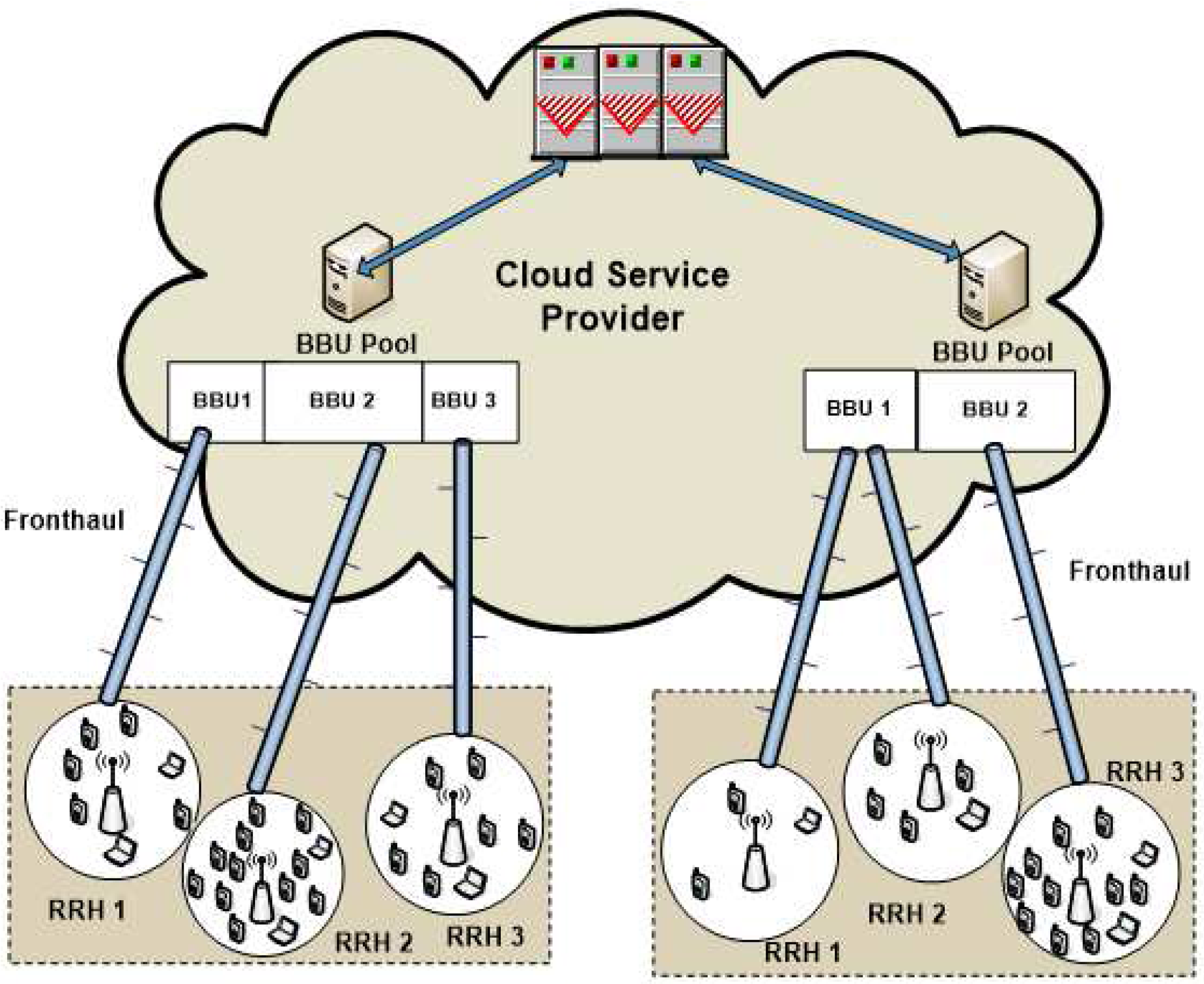
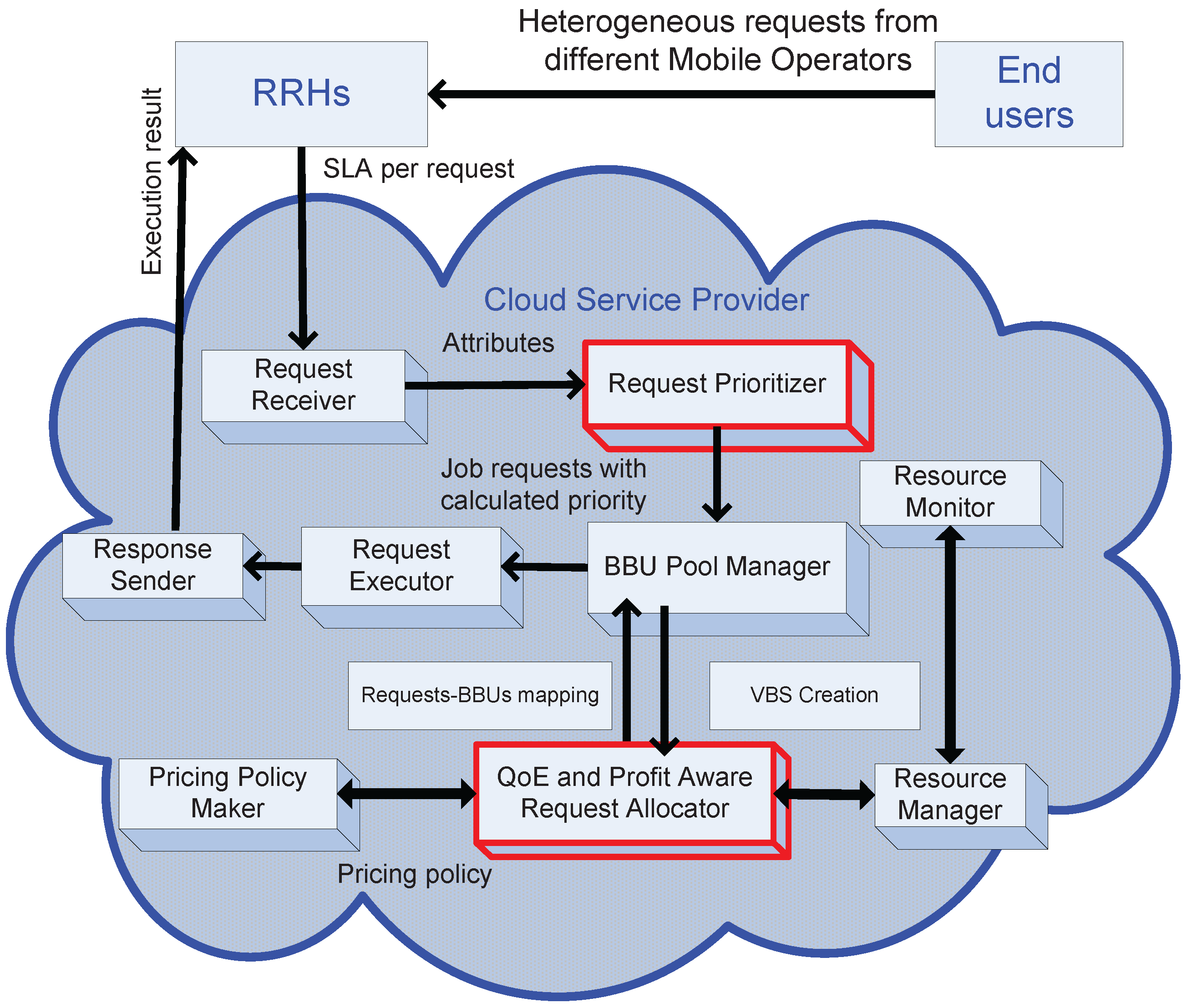
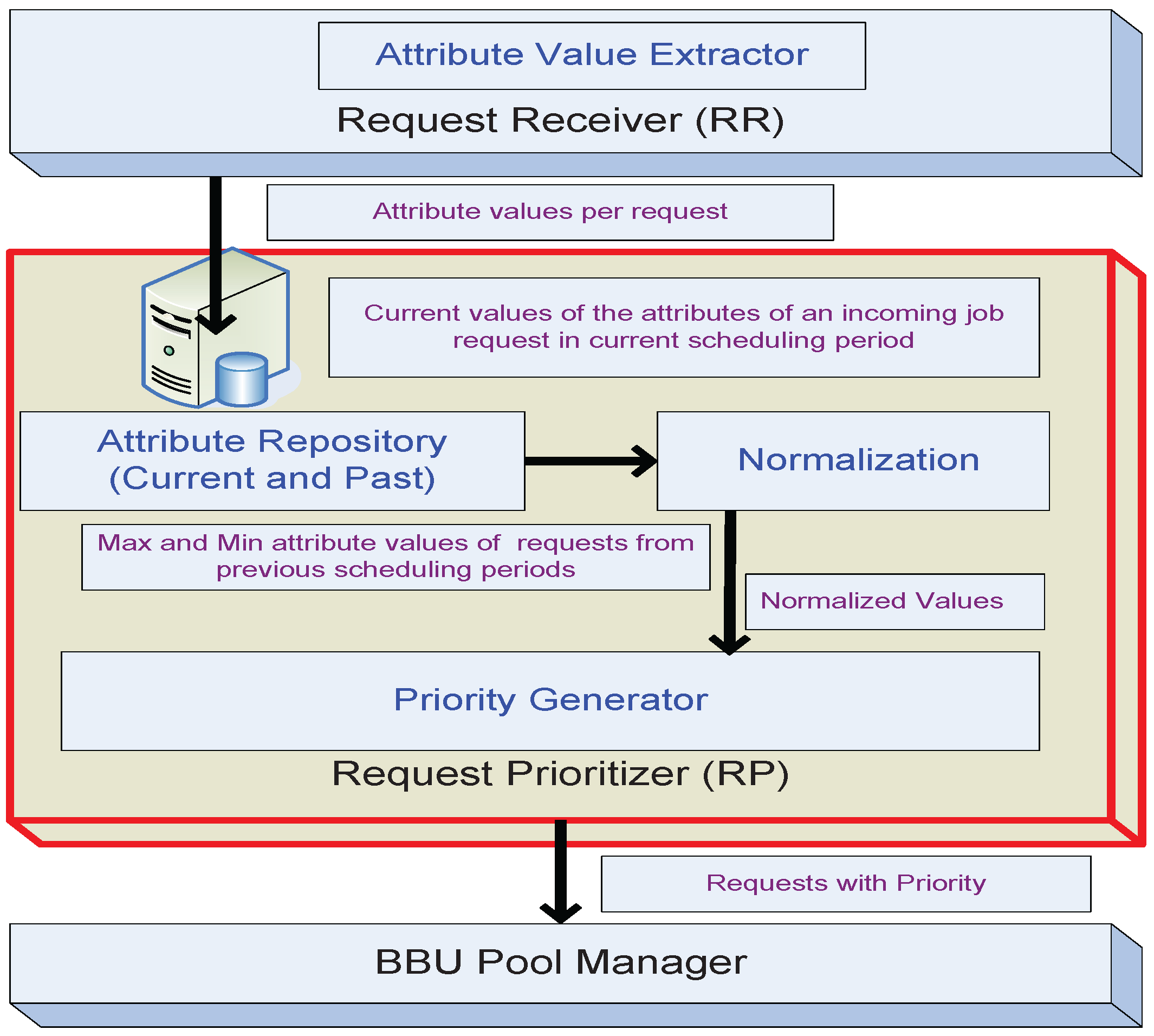

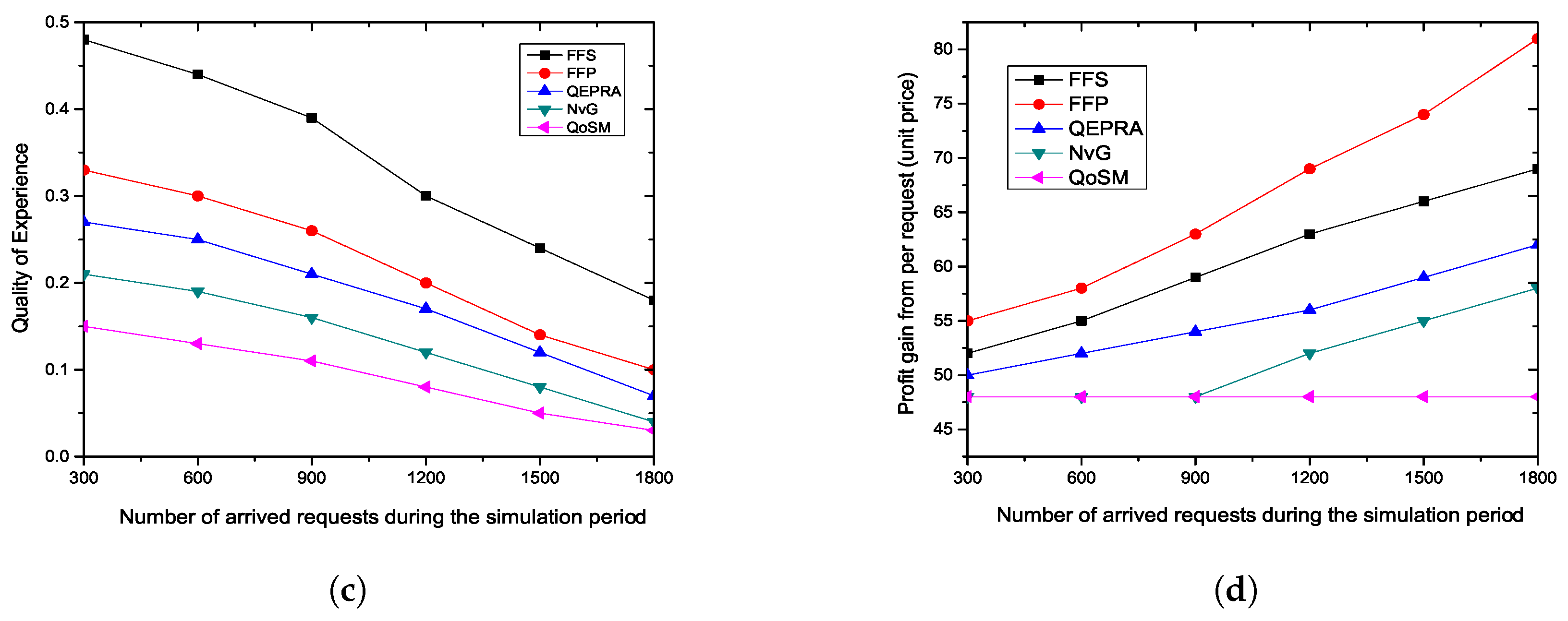

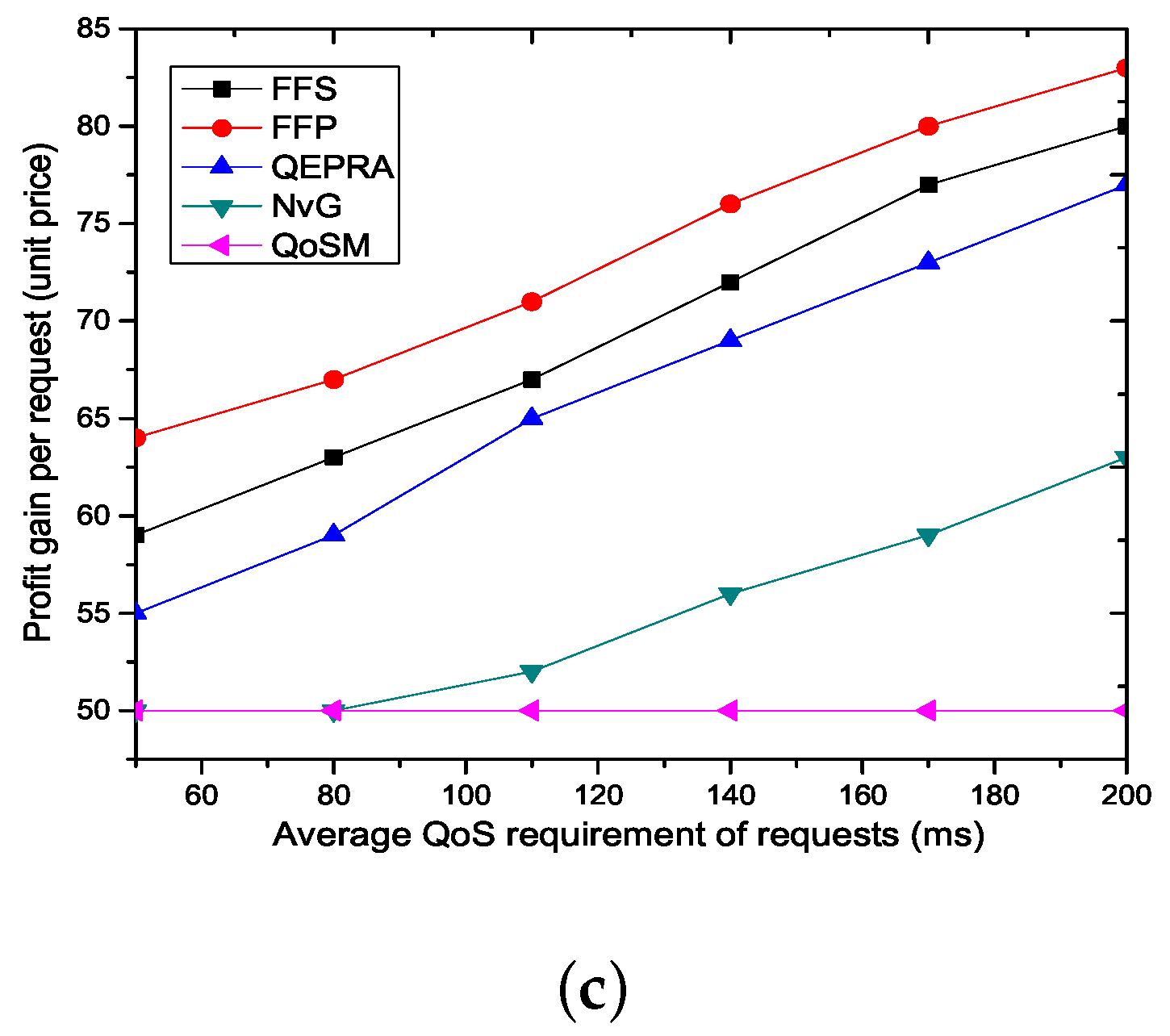
| State-of-the-Art Works | QoS | User QoE | Profit | Resource Utilization |
|---|---|---|---|---|
| VBS Provisioning [12] | (Partially) | |||
| VRAN-PAP [13] | (Partially) | |||
| Fluidnet [16] | ||||
| RRH Clustering [15] | ✓ | |||
| QoSM [6] | ✓ | |||
| NvG [9] | ✓ | ✓ | ||
| QEPRA [Proposed] | ✓ | ✓ | ✓ | ✓ |
| Symbol | Definition |
|---|---|
| R | Set of all incoming computational resource requests |
| H | Set of all remote radio heads (RRHs) |
| B | Set of all base band units (BBUs) in a BBU Pool |
| Set of attributes of a request, | |
| Incoming data of a request, to be processed | |
| The QoS requirement of an incoming request, | |
| The received signal strength of the connected device associated with a request | |
| The priority of an incoming request | |
| Set of objective parameters considered for executing a request, | |
| Cloud service providers’ profit for executing a request, on a BBU, | |
| Total time requires a RRH, to get first response from a BBU, after executing a request, | |
| The number of scheduling intervals required for a request, to be assigned to BBU | |
| Scheduling interval of the system for allocating resources | |
| BBU rental cost for executing a request | |
| Monetary cost for other resource usage |
| Parameter | Value |
|---|---|
| Number of BBU | 5 |
| BBU processing speed | 20∼50 MHz |
| Number of RRH | 10 |
| Incoming data per request to be processed | 20∼600 KB |
| Maximum allowable delay (QoS) | 20∼200 ms |
| RSSI value | −15∼−75 dB |
| Simulation Duration | 500 s |
© 2017 by the authors. Licensee MDPI, Basel, Switzerland. This article is an open access article distributed under the terms and conditions of the Creative Commons Attribution (CC BY) license (http://creativecommons.org/licenses/by/4.0/).
Share and Cite
Afrin, M.; Razzaque, M.A.; Anjum, I.; Hassan, M.M.; Alamri, A. Tradeoff between User Quality-Of-Experience and Service Provider Profit in 5G Cloud Radio Access Network. Sustainability 2017, 9, 2127. https://doi.org/10.3390/su9112127
Afrin M, Razzaque MA, Anjum I, Hassan MM, Alamri A. Tradeoff between User Quality-Of-Experience and Service Provider Profit in 5G Cloud Radio Access Network. Sustainability. 2017; 9(11):2127. https://doi.org/10.3390/su9112127
Chicago/Turabian StyleAfrin, Mahbuba, Md. Abdur Razzaque, Iffat Anjum, Mohammad Mehedi Hassan, and Atif Alamri. 2017. "Tradeoff between User Quality-Of-Experience and Service Provider Profit in 5G Cloud Radio Access Network" Sustainability 9, no. 11: 2127. https://doi.org/10.3390/su9112127





